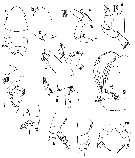
issued from : H.S.J. Roe
in Bull. British Mus. (Natural History) Zool., London, 1975, 28 (7). [p.368, Fig.33].
Female (from 18°N, 25°W): a, Cephalothorax (dorsal); b, forehead (lateral); c, last thoracic segment and urosome (lateral); d, A2; e, Md; f, Mx1; g, Mx2; h, Mxp; i, P1; j, P2; k, P3; l, P4; m, P5.
Bar scale 0.1 mm unless indicated.
Nota: Rostrum curved spike containing a central groove, presumably formed of two more or less filaments.
Cephalothorax about5 times longer than the 4-segmented abdomen.
Head and 1st thoracic segment separate, 4th and 5th separate.
last thoracic segment slightly produced laterally.
Mx1 (Fig.33f) has a damaged 1st outer lobe; the other Mx1 of the same specimen has 7 large and 2 small setae on this lobe.
In Mx2 all the lobes are at the distal end of the appendage; 4th lobe with 3 large curved setae, furnished with many small spines; 5th lobe with 2 such setae and 2 small ones; endopodite with 8 long thin filaments which, as far as can be seen, all taper to a fine point, none of them is brush-like.
P2 to P4 are incomplete but the endopodites of P2 and P3 are covered with fairly large spines.
P5 small and uniramous; each side has 3 segments, the 3rd having a long internal spine and 2 shorter stout spines; on one side the surface of the 3rd segment has 2 small spines.




